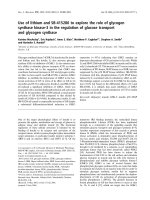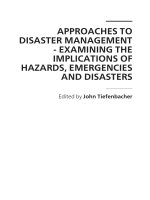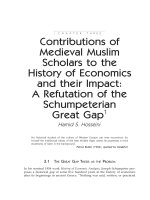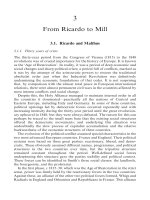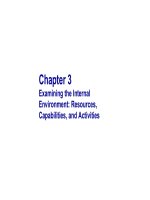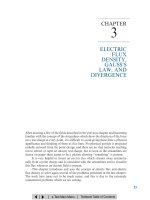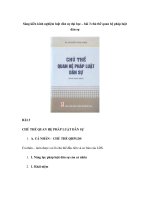Chapter 3 - Examining the Internal Environment: Resources, Capabilities, and Activities ppsx
Bạn đang xem bản rút gọn của tài liệu. Xem và tải ngay bản đầy đủ của tài liệu tại đây (387.34 KB, 19 trang )
Chapter 3
Examining the Internal
Environment: Resources,
Capabilities, and Activities
2
OBJECTIVES
1
2
3
4
5
Explain the internal context of strategy
Identify a firm’s resources and capabilities and explain
their role in its performance
Define dynamic capabilities and explain their role in both
strategic change and a firm’s performance
Explain how value chain activities‑ are related to firm
performance and competitive advantage
Explain the role of managers with respect to resources,
capabilities, and value chain activities‑
3
COMPARATIVE INDUSTRY REFORMANCE
How do
such differences in
profitability
materialize?
ROA
ROS
Grocery Store
Global Auto
Semiconducto
r
4
RESOURCES, CAPABILITIES, AND MANAGERIAL DECISIONS
Strategy
Competitive
advantage/
disadvantage
Management
strategic decision
making
Capabilities
Managers
Resources
Performance
5
RESOURCES AND CAPABILITIES: FUNDAMENTAL BUILDING
BLOCKS OF STRATEGY
The inputs that firms use to create goods
and services
•
Undifferentiated or firms-specific
•
Tangible or intangible
•
Easy to acquire or difficult
A firm’s skill in using its resources
to create goods and services.
The combination of procedures
and expertise that the firm relies
on to engage in distinct activities
in the process of producing goods and
services
C
a
p
a
b
i
l
i
t
i
e
s
(
c
o
m
p
e
t
e
n
c
i
e
s
)
R
e
s
o
u
r
c
e
s
Strategy
6
TRUST AS AN ORGANIZATIONAL RESOURCE
Trust is an intangible resource
1
A trustworthy reputation for a firm can
be leveraged.
2
7
KNOWLEDGE
Knowledge as
a resource
Explicit (easy
competitive
intelligence)
Tacit (more
valuable)
8
EXAMPLES OF CAPABILITIES
1: Stalk, Evans, and Shulman, 1992
2: Makadok, 2003
Capability Result
Logistics distributing vast amounts of
goods quickly and efficiently to remote
locations
An extraordinarily frugal system for
delivering the lowest cost structure in the
mutual fund industry, using both techno-
logical leadership and economies of scale
Generating new ideas then turning those
ideas into new, profitable products
200,000-percent return to share-
holders during first 30 years
since IPO
1
25,000-percent return to share-holders
during the 30-plus year tenure of CEO
John Connelly.
2
As for ongoing expenses, share-
holders in Vanguard equity funds pay,
on average, just $30 per $10,000, vs.
a $159 industry average. With bond
funds, the
bite is just $17 per $10,000
30 percent of revenue from products
introduced within the past four years
Company
9
THE VRINE MODEL
Performance implicationTest Competitive implication
Valuable? Does the resource or capability allow the
firm to meet a market demand or protect
the firm from market uncertainties?
If so, it satisfies the value requirement.
Valuable resources are needed just to
compete in the industry, but value by
itself does not convey an advantage
Valuable resources and capabilities
convey the potential to achieve “normal
profits” (i.e., profits which cover the cost
of all inputs including the cost of capital)
Rare? Assuming the resource or capability is
valuable, is it scarce relative to demand?
Or, is it widely possessed by most
competitors?
Valuable resources which are also rare
convey a competitive advantage, but its
relative permanence is not assured.
The advantage is likely only temporary.
A temporary competitive advantage
conveys the potential to achieve above
normal profits, at least until the
competitive advantage is nullified by
other firms
Inimitable
and non-
substitut-
able?
Assuming a valuable and rare resource,
how difficult is it for competitors to either
imitate the resource or capability or
substitute for it with other resources and
capabilities that accomplish similar
benefits?
Valuable resources and capabilities
which are difficult to imitate or substitute
provide the potential for sustained
competitive advantage
A sustained competitive advantage
conveys the potential to achieve above
normal profits for extended periods of
time (until competitors eventually find
ways to imitate or substitute or the
environment changes in ways that nullify
the value of the resources)
Exploit-
able?
For each step of the preceding steps
of the VRINE test, can the firm actually
exploit the resources and capabilities that it
owns or controls?
Resources and capabilities that
satisfy the VRINE requirements but
which the firm is unable to exploit
actually result in significant opportu-
nity costs (other firms would likely
pay large sums to purchase the
VRINE resources and capabilities).
Alternatively, exploitability unlocks
the potential competitive and perfor-
mance implications of the resource
or capability
Firms which control unexploited VRINE
resources and capabilities generally
suffer from lower levels of financial
performance and depressed market
valuations relative to what they would
otherwise enjoy (though not as
depressed as firms lacking resources
and capabilities which do satisfy VRINE)
10
SUSTAINABILITY
Sustainability:
Just having a
competitive
advantage is not
enough. Can it
be sustained?
Durability
Imitability
11
TANGIBLE AND INTANGIBLE ADVANTAGES
=
=
=
Intangible
Location selection
Brand
Tangible
Rural real-estate
High traffic
real-estate
+
+
+
Wal-Mart
McDonald’s
12
HOW WOULD YOU DO THAT?
Inimitable and
non-substitutable?
Can competitors imitate?
Can they substitute?
Exploitable? Can Pfizer exploit?
Rare?
Do Pfizer's patents provide
“rarity”?
Valuable?
Do patents on Zoloft ®
provide value?
Pfizer’s
Zoloft ®
13
DYNAMIC CAPABILITIES
Mail Boxes Etc. franchise
Value
Dynamic capability:
how we integrate recon-
figure, acquire, or divest
resources for competitive
advantage?
Mail boxes, etc.,
has developed the
ability to combine
resources better
than the
competition
Start-up plans
People
Brand
Location
Processes
14
VALUE CHAIN: INTERNET STARTUP EXAMPLE
Inbound
shipment of
top titles
Warehousing
Server
operations
Billing
Collections
Picking and
shipment of top
titles from
warehouse
Shipment of other
titles from third-
party distributors
Pricing
Promotions
Advertising
Product
information and
reviews
Affiliations with
other websites
Returned items
Customer
feedback
CDs
Shipping
Computers
Telecom lines
Shipping
services
Media
Inventory
system
Site
software
Pick & pack
procedures
Site look & feel
Customer research
Return
procedures
Financing, legal support, accounting
Recruiting, training, incentive system, employee
feedback
Procurement
Technology
Development
Human
Resources
Firm
Infrastructure
Support
Activities
Inbound
Logistics
Operations Outbound
Logistics
Marketing
& Sales
After-Sales
Service
Primary Activities
15
GUIDELEINES FOR OUTSOURCING
Activities that can create value for the
firm should not be outsourced.
1
Those activities that represent key
sources of learning for the firm should
not be outsourced.
2
16
USING VALUE CHAINS TO GAIN COMPETITIVE ADVANTAGE
Identical Differentiated
Find a different
way to perform
activities
Find a better way
to perform the same
activities
Longer-lasting
advantage
Shorter-term
advantage
(competitors
catch up)
17
TRADE OFF PROTECTION YOUR RIVALS CHOOSE NOT TO COPY YOU
Selected difference between Southwest and large Airlines
Southwest
made choices so
that competitors
did not copy -
because copying
would require
them to
abandon
activities
essential to their
strategies
Technology
and design
Operations
Marketing
Southwest
• Single aircraft
• Short segment flights
• Smaller markets and secondary
airports in major markets
• No baggage transfers to others
airlines
• No meals
•
Single class of service
• No seat assignments
• Limited use of travel agents
• Word of mouth
Major Airlines
• Multiple types of
aircrafts
• Hub and spoke
system
•
Meals
• Seat assignments
• Multiple classes of
service
•
Baggage transfer to
other airlines
• Extensive use of
travel agents
18
INNOVATION AND INTEGRATION OF THE VALUE CHAIN
Transferred assembly and delivery
to the consumer
Choose an entirely direct distribution model
(rather than through retailers) and outsourced
component manufacturing
IKEA
Dell
S
o
u
r
c
e
A
s
s
e
m
b
l
e
D
e
l
i
v
e
r
Area of innovation
19
STRATEGIC LEADERSHIP
“Companies that overlook the role of leadership in
the early phases of strategic planning often find
themselves scrambling when it’s time to execute.
No matter how thorough the plan, with-out the right
leaders it is unlikely to succeed”
– McKinsey & Company


